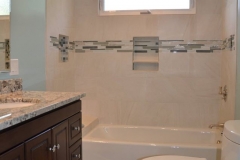Bathroom Remodel: Set up your bathroom just the way you want. You can finally have the bathroom you’ve always wanted. We will work with you every step of the way to make sure our work reflects exactly what you had in mind. We’ll get the job done with as little interruption of your daily life as possible.
Here are things to consider before remodeling your bathroom, whether you have a simple powder room or a master en suite, functionality should be at the heart of your bathroom remodel. Gain more storage, improve lighting and drainage, and more to ensure that your renovated bathroom stands the test of time.
Plumbing: Residential plumbing typically uses 1½-inch pipes for drains. You’d be surprised how much gunk and hair goes down that drain. The larger the drain, the less likely it is to clog. The cost difference to upgrade to a 2-inch drain is practically negligible, and unless your framing doesn’t allow for it, you should consider increasing the drain in your shower to 2 inches.
Lighting: Consider recessed light fixtures to brighten up the bathroom. Install a dimmer switch so you can adjust the mood in your bathroom. Consider how you’ll be using the mirrors and whether you want aesthetic or functional lighting. Bright light fixtures go a long way to help you see what you’re doing close up.
Medicine cabinets: Plan for adequate space to recess your medicine cabinet is a great way to save a few inches of space over a shallow vanity, and the additional framing typically isn’t going to break the budget. If that’s not an option, ensure that you have enough room at your vanity to have your medicine cabinet protrude by 4 to 5 inches.
Wall-hung toilets: These fixtures have grown in popularity lately, and for good reason. They no longer break the bank, and they also save space since the tank is hidden behind the wall. However, if you ever change your mind and opt for a floor-mounted unit, you’ll have to rework the water supply and drainage.
A window in the shower: This is a great feature. Choose a frosted-glass panel for privacy and preferably one that opens for fresh air. Make sure there are stone jambs along the entire installation so that this area is watertight and that the sill slopes down and away for proper drainage. Specify a tilt-and-turn window in the shower, because the screen is located on the outside of the window; the handles are plastic, so they won’t rust; and make sure the window provides full privacy even when tilted open.
Shower sills. Ensure that they are sloped properly into the shower. Choose a material that is solid, like stone or quartz. If you tile your shower curb, water can sit on the grout lines and eventually seep through to the framing.
Shower floors: Larger tiles are typically more difficult to slope properly, and unless they’re textured, they’ll be slipperier because the grout lines are further apart. Smaller tiles, whether textured or not, offer more traction and are typically the norm for shower floors.
Shower bases: Gone are the days of boring beige prefabricated shower bases. Use shower systems that have modern, clean bases made out of acrylic or porcelain. Consider all the options.
Drawer storage. Consider installing a vanity with drawer storage rather than doors. Drawers are easier to access and easier to organize. They can be cut out around the plumbing and can be extra large to accommodate large items.
Shower or tub? Before you decide, consider how many baths you take a year. The renovation is not for a future buyer, but for yourself. Even if you live in your house only for another five years, it’s worth it to do it for yourself.



